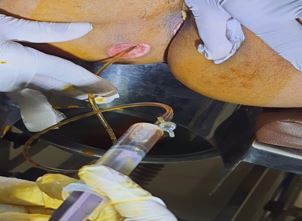Effect of Saindhavadya Taila in the management of Bhagandar after IFTAK - A Case Study
Keywords:
Bhagandar, Fistula-in-Ano, IFTAK, Saindhavadya TailaAbstract
Fistula is a chronic granulating tract or cavity communicating the rectum or anal canal to the perineal skin. The ideal treatment for Fistula-in-Ano is to eradicate primary source of infection. Fistulotomy or fistulectomy have good results in simple low anal fistula. In complex Fistula-in-Ano there are high chances of recurrence, incontinence and loss of natural anatomical structure. In Ayurveda there is reference for Fistula-in-Ano as Bhagandar. It can be treated by total excision or laying open. Sushruta (500 B.C.), the father of Surgery has mentioned safe, alternate and minimally invasive treatment of Ksharsutra (Medicated Seton). Now a days Ksharsutra is prepared by smearing Apamarga Kshara, Snuhi Ksheera and Haridra on surgical linen thread No. 20. The duration of treatment of Ksharsutra is long depending on the length of tract, patient have to give follow up till cutting of whole tract weekly. To overcome these problems now a days IFTAK (Interception of Fistula Tract with Application of Ksharsutra) is practiced. In this procedure only proximal, small part of tract is laid open and Ksharsutra applied to that much part only. In this procedure there are no chances of sphincter damage. After IFTAK now a days irrigation with Betadine daily is practiced, we have tried Saindhavadya Taila for faster healing of the Fistula tract and IFTAK wound.
Downloads
References
A concise textbook of surgery by S Das. 6st edition-2010 P 956-959.
Acharya Sushruta, Sushruta Samhita, Nidan sthana, 4th chapter, Shloka.4, Hindi translated by Shri. Ambika Dutta Shastri. Varanasi: Chaukhambha Sanskrit Sansthan;11th edition.1997.P.244.
Acharya Vagbhata, Ashtanga Hridaya, Nidan sthana, 28th chapter, Shloka.1,2, Dr.Brahmanand Tripathi. Delhi: Chaukhambha Surbharti Prakashan; reprint-2003.P.1092.
Bhaishyajyaratnavali, chapter no 39, By Shri. Ambika Dutta Shastri. Chaukhambha Sanskrit sansthan, Varanasi. edition-1997.page-610.
Yogaratnakar, Uttarardha, shoka -01, by Vaidya Laxmipati sastri, Chaukhambha Sanskrit sansthan, Varanasi, 6th edition-1997.page-195.
Yogaratnakar, Uttarardha, shoka -01& 02, by Vaidya Laxmipati sastri, Chaukhambha Sanskrit sansthan, Varanasi, 6th edition-1997.page-199.
Yogaratnakar, Uttarardha, shoka -01& 02, by Vaidya Laxmipati sastri, Chaukhambha Sanskrit sansthan, Varanasi, 6th edition-1997.page-199.
Yogaratnakar, Uttarardha, shoka 3, by Vaidya Laxmipati sastri, Chaukhambha Sanskrit sansthan, Varanasi, 6th edition-1997.page-195.
Yogaratnakar, Uttarardha, shoka -01-04, by Vaidya Laxmipati sastri, Chaukhambha Sanskrit sansthan, Varanasi, 6th edition-1997.page-183.
M. Sahu A Manual on Fistula in ano and Kshara Sutra therapy first edition Varanasi NRCKT, Pg 184.















